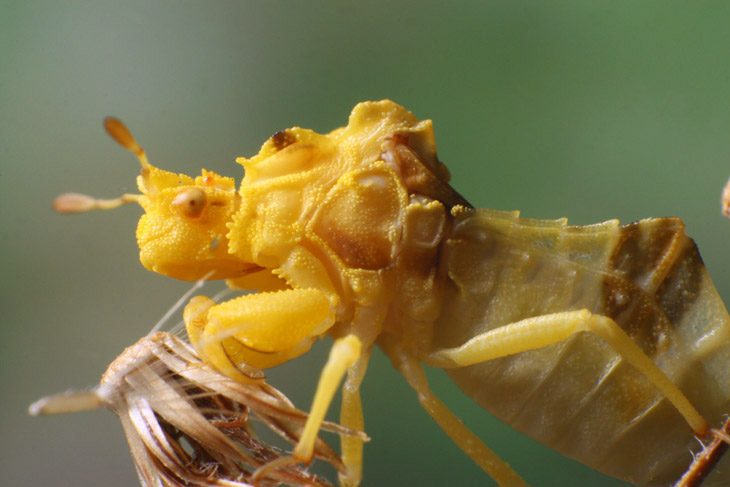
Catching up is taking a lot longer than anticipated, but a lot of that has to do with being busy with other things, among them updating the materials for the photo students, who come first (well, no, The Girlfriend comes first, but the students are still ahead of the blog.) I’ve also tried to space out the photos with a couple of critical-thinking posts, but the flow of writing is not to my liking so far, and if I can’t pass my own editing standards, as loosely as that word may be used, then it’s probably best not to put it up.
While out doing the shots from part one, I found a pair of jagged ambush bugs, genus Phymata – I wasn’t going to be able to do them justice out in the field, so I collected them for a studio shoot. I’ve done a fair amount with them previously, but that was all with the early nymph
forms, while these two were adults. “Adult” does not mean “big” – the specimens seen here were a whopping 10mm in body length, and it was only through experience with the species that I even spotted them at all.
 Ambush bugs are predatory ‘true bugs,’ or Hemipterans, and usually find themselves a perch on a likely flower and await the appearance of pollinators. To say that they are sedentary is perhaps understating it; I have never seen one actually going anyplace, and even when provoked they are reluctant to give up their position. Both of these (if you can’t tell them apart that’s okay, neither can I) possessed wings and yet never made any attempt to fly away. This leads me to speculate that they rely almost entirely on their camouflage and caruncular exoskeleton for defense; usually they blend in much better than this, but we had no yellow flowers around to use as a setting. Also, since a lot of species count on movement rather than appearance in spotting prey, the tendency towards immobility that these bugs appear to possess might be sufficient all by itself. We’ll see more about that shortly. Right now, we’ll go in for a little closer look at the business end of things.
Ambush bugs are predatory ‘true bugs,’ or Hemipterans, and usually find themselves a perch on a likely flower and await the appearance of pollinators. To say that they are sedentary is perhaps understating it; I have never seen one actually going anyplace, and even when provoked they are reluctant to give up their position. Both of these (if you can’t tell them apart that’s okay, neither can I) possessed wings and yet never made any attempt to fly away. This leads me to speculate that they rely almost entirely on their camouflage and caruncular exoskeleton for defense; usually they blend in much better than this, but we had no yellow flowers around to use as a setting. Also, since a lot of species count on movement rather than appearance in spotting prey, the tendency towards immobility that these bugs appear to possess might be sufficient all by itself. We’ll see more about that shortly. Right now, we’ll go in for a little closer look at the business end of things.

From the inordinate size of the base of those pincers, I have to assume they’re quite strong, but despite what appears to be visible serrations, they’re for holding, not cutting. Hemipterans are, of course, sucking bugs, using a long proboscis to draw their nutrients – you can see it in shadow under the insect’s ‘chin’ – so they would derive no benefit from breaking up their meals in any way; indeed, it would reduce the fluids they eat. And from other images that I’ve gotten in the past, I can say that one of those surfaces on the pincer is actually flat. Note, too, the fine hairs arranged along the edges, which allow the ambush bug to feel their prey and know whether it is perfectly immobilized or not. These can be found on many species of crab, which are also arthropods, and I can tell you from experience that disturbing them usually triggers the pincers to slam shut automatically (much to my chagrin with a sizable pet hermit crab, many years ago.)
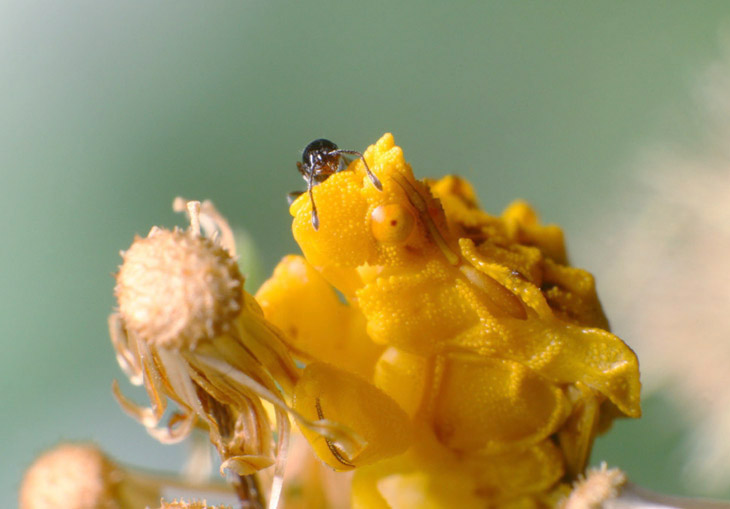
I failed to notice, as I selected a weed stem to use as a prop, that the plant was home to numerous aphids and, in turn, several tiny black ants that were ‘milking’ them. This meant that every couple of minutes an ant would venture up to the top and usually right across the ambush bug. You might imagine this would be bad news for the ant, but the ambush bug largely ignored the impertinence, save for producing some sharp jerks of its head when an ant traipsed thereon. You can also see the natural groove that the antenna fits into when drawn back; ambush bugs seem very protective of their antennae, and it took some time without disturbance before it would extend them again, slapping them back as soon as I loomed too close with the camera.
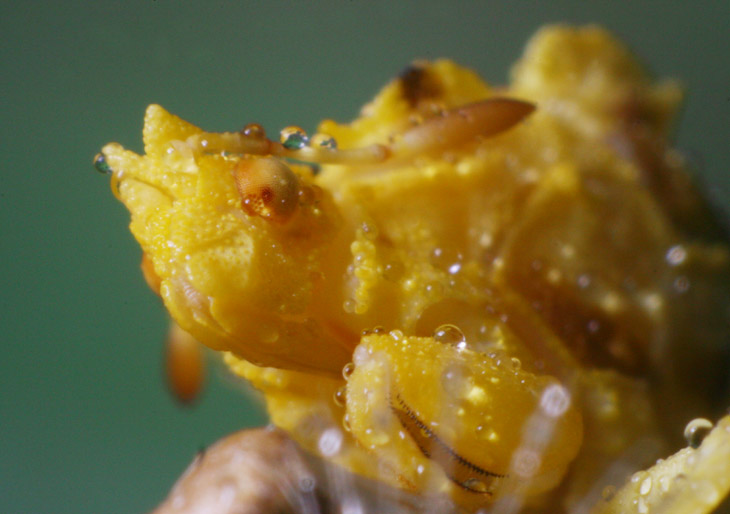
I gave them both a misting while I had them, only partially for the photographic possibilities, but more because they’d been in a film can for hours and I figured they might need the water (neither of them showed the faintest interest in gathering any of the moisture.) I included this image because one of the droplets formed a nice lens on the compound eye, magnifying the underlying ommatidia. I can’t tell you what affect this might have on the perceptions of the bug, except that they’re likely used to it, because it can happen during any rain and overnight dew. But there’s one other detail that I want to highlight, because I apparently haven’t featured it here before.
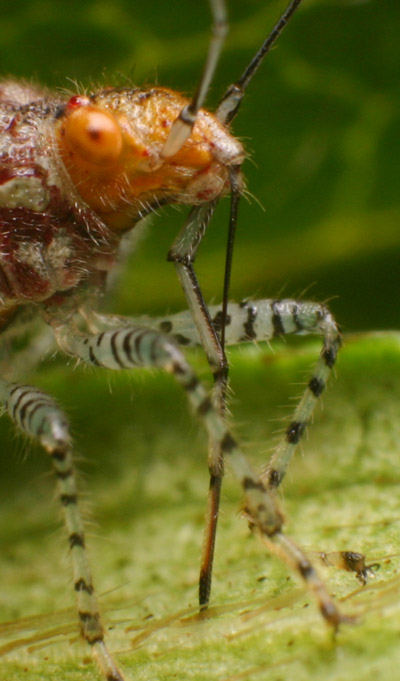 If you look closely at the base of the proboscis in the image above, right at the point of the ‘nose,’ you can see a little gap with a paler, ridged something in there. The proboscis is actually a multi-part appendage, as I discovered by accident in some previous macro pics, prompting me to seek more like the one at left. There is a hard outer ‘cutting/stabbing’ sheath, often articulated, called the labium. Fitting within it are the bits that do the actual drinking, looking like a fine thread even though there are actually four parts, collectively called the stylets, separately a pair each of mandibles and maxillae, terms you might recognize from just about any anatomy lesson, otherwise known as the lower and upper jaws respectively. The separate nature of the labium and stylets is nicely shown with this scentless plant bug (Niesthrea louisianica) that obligingly posed for me while feeding from a leaf. Diagrams and explanations of all this can be found here.
If you look closely at the base of the proboscis in the image above, right at the point of the ‘nose,’ you can see a little gap with a paler, ridged something in there. The proboscis is actually a multi-part appendage, as I discovered by accident in some previous macro pics, prompting me to seek more like the one at left. There is a hard outer ‘cutting/stabbing’ sheath, often articulated, called the labium. Fitting within it are the bits that do the actual drinking, looking like a fine thread even though there are actually four parts, collectively called the stylets, separately a pair each of mandibles and maxillae, terms you might recognize from just about any anatomy lesson, otherwise known as the lower and upper jaws respectively. The separate nature of the labium and stylets is nicely shown with this scentless plant bug (Niesthrea louisianica) that obligingly posed for me while feeding from a leaf. Diagrams and explanations of all this can be found here.
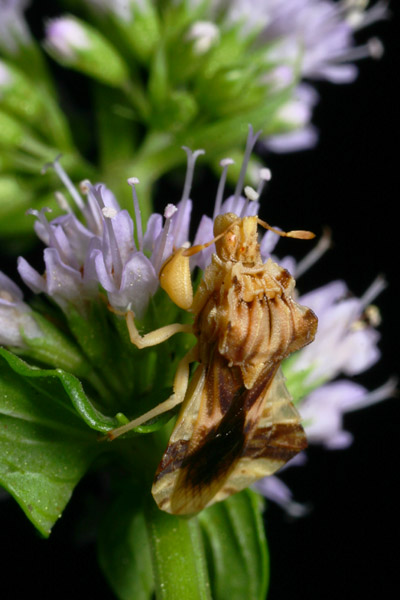 After the photo session, I took both ambush bug specimens out and tried to find appropriate places for them. One went onto the flowers of the spearmint plants, and the other onto a geranium bloom – like I said, we don’t have any yellow flowers around here. The geranium was apparently unacceptable, since I haven’t seen it there since, but the one on the mint seemed to be okay with the choice, considering that it is still there as I type this, a week since its release – that’s it in the pic, obviously not camouflaged terribly well, yet still in flattering colors (if I’m any judge, which I’m probably not.) Faintly visible in this image is the red spot on the back of the ‘skull,’ also visible in one of the photos above and the one with the scentless plant bug. These are small simple eyes called ocelli, primarily believed to help flying insects maintain stable flight. If you roll back a few posts, you can see them on the mantises and the cicada as well.
After the photo session, I took both ambush bug specimens out and tried to find appropriate places for them. One went onto the flowers of the spearmint plants, and the other onto a geranium bloom – like I said, we don’t have any yellow flowers around here. The geranium was apparently unacceptable, since I haven’t seen it there since, but the one on the mint seemed to be okay with the choice, considering that it is still there as I type this, a week since its release – that’s it in the pic, obviously not camouflaged terribly well, yet still in flattering colors (if I’m any judge, which I’m probably not.) Faintly visible in this image is the red spot on the back of the ‘skull,’ also visible in one of the photos above and the one with the scentless plant bug. These are small simple eyes called ocelli, primarily believed to help flying insects maintain stable flight. If you roll back a few posts, you can see them on the mantises and the cicada as well.
It is unfortunate that I discovered the ambush bugs after this next subject, since it might have meant a nice meal for them, one I wouldn’t have begrudged at all. But on the same spearmint plant one evening, I spotted a peculiar outgrowth on the flower spike, quickly revealed as not growth at all.
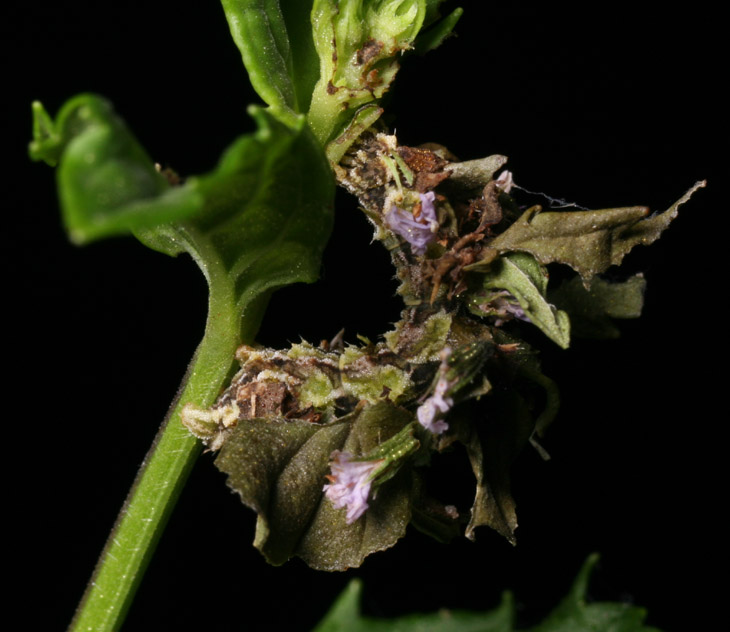
As hard as this is to make out, this is the caterpillar of a wavy-lined emerald moth (Synchlora aerata,) demonstrating their typical active camouflage defense. These caterpillars detach bits of plant matter from the plant they’re feeding upon and attach it to their backs to blend in, which works surprisingly well, unless you spot the break in the expected pattern. Here, the caterpillar is sporting larger brown mint leaves, obviously drying out, and some of the mint flowers; the natural color of the caterpillar is displayed along the inchworm arc to the left. You can see other illustrations of them here, and here – it’s plain that they can also adapt their body color to fit in better.

It took several attempts, since the inchworm was alert to my presence and hid its head every time I leaned in for the detail shot, but I managed to get the barest photo of it feeding – the ones at the second link above are better. There are three pairs of forelegs, two plainly visible and one in shadow but betrayed by the hint of texture. These little guys can do a surprising amount of damage, and I was first alerted to their presence by the turds deposited on leaves below, even though it took another day to find the ninja pooper. Since the spearmint plants are my favorites, messing with them is not allowable, and it’s a show of extreme tolerance that I even got these images first. Immediately afterward, this and another caterpillar were detached and tossed far afield; I can only hope the ambush bug is at least protecting its own flower spike from a return.




















































